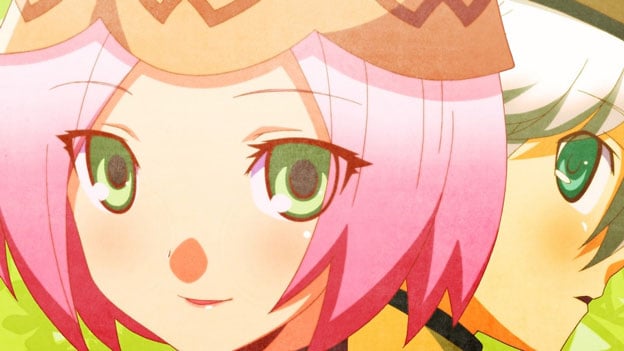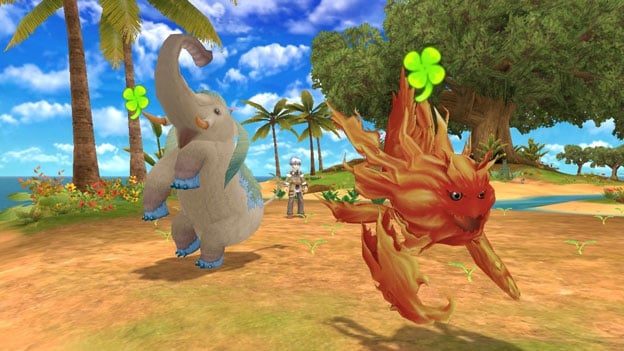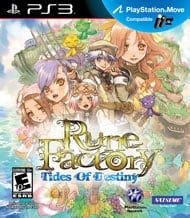Yo Ho, Yo Ho, A Golem’s Life For Me
Sucker-punching gigantic sea monsters with an oversized plant golem isn’t exactly the first activity that comes to mind when one thinks of Japanese farming simulation games. That’s the beauty of Rune Factory: Tides of Destiny, the second home console game in the Rune Factory series: it’s a farming sim for people who don’t like farming sims, although it will appeal to most fans of the genre as well. Set in a small town on an island, there’s a maritime theme to this game that works surprisingly well.
Let’s not beat around the bush; Tides of Destiny has a rocky beginning that unfortunately showcases the game’s shortcomings. The introduction, in which best friends Aden and Sonja find themselves trapped in the same body and magically transported to a different version of their home island, is awkward and hindered by stilted voice acting. The game’s main features are introduced fairly slowly and the player will need to pay very close attention to all on-screen instructions. The manual is patently unhelpful and the tutorials that can be consulted in-game are incomplete. The player may feel a bit lost in this little fantasy-themed village, searching for a way to move the storyline along. My tips? Talk to everyone in town and examine every interesting-looking object, and eventually you’ll be back on track again.

Once it gets going, however, the game has some of the best gameplay in the history of farming simulations, or more correctly in this case, fantasy life simulations. Tides of Destiny includes farming, to be sure, but it’s a pared-down version with most of the micromanagement and attendant tedium removed. Instead, the game quickly presents the player with its two main focuses: befriending/helping out villagers and exploring the ocean on top of a gigantic friendly golem named Ymir.
Like Rune Factory 3 before it, Tides of Destiny features a quest board that helps to guide the player through the game’s many tasks. Although there are a few simple fetch or monster-slaying quests, most quests involve at least some story that helps the player get to know the game’s townsfolk better. I can’t overstate how nice it is to be able to spice up the endless rounds of gift-giving that usually rule social interactions in farming sims. We’ll cover the cast of characters later, but for now I’ll say that the social system in Rune Factory continues to be more multifaceted and interesting than that of its sister series, Harvest Moon.

Quests also lead the way to advancing the game’s storyline, which involves Aden and Sonja’s quest to separate back into two people by riding Ymir the golem around the ocean and discovering what’s out there. Does it make sense, particularly at first? Not really. Is it fun? You bet! The townsfolk relay legends and rumors about surrounding sea to the main characters, who plot a destination on a sea chart and can either put the golem on auto-pilot or control it manually. Ymir stomps satisfyingly through the waters and lifts islands, shrines, and shipwrecks out from the murky depths. The player can then disembark and explore Ymir’s finds, usually fighting plenty of monsters along the way.
The Rune Factory series has been slowly improving its action combat system, and this is probably the best one yet. For the first time, the main character can jump, and Aden’s acrobatic, flipping double-jump gives the player a lot more control over battles than previous games have had. No longer will the Rune Factory protagonist become stuck in a corner, surrounded by monsters that constantly interrupt attempts to chug a healing potion. Instead, Aden can use his jumps to get out of corners, dodge enemy attacks, and even attack and change direction in mid-air. Beyond the jumping, Tides of Destiny’s combat is swift and fluid, even providing special moves that are learned as Aden becomes more proficient with particular weapons. It’s still a fairly simple combat system, and fast weapons continue to beat slow weapons due to a lack of defensive moves, but it’s more fun and interesting than ever before in the Rune Factory series.
Sometimes the player will also need to fight while controlling Ymir, who sometimes lifts giant kraken, sea serpents, and the like from the ocean floor. Ymir can block and punch with his huge fists, making sea battles reminiscent of Rock ‘Em Sock ‘Em Robots. There’s something quite appealing about these fights, especially since many of the sea monsters have a nice visual design.

Beyond socializing and exploration, there are plenty of other things to do in Tides of Destiny. Crafts practiced in the game include forging, cooking, medicine-making, crafts, and carpentry. Of these, forging, cooking, and crafts are particularly important, as they are the main ways to improve Aden’s equipment and keep him healthy. The basic ingredients for these crafts are gathered in various ways. Many items drop off of monsters when they’re defeated or can be bought in shops. Fish are caught from various bodies of water in a simple timed button press mini-game, similar to the one that is used while crafting. Farm products and ores are collected through the game’s new farming system, which is quite different from the system in any previous Rune Factory or Harvest Moon games.
Farming sim games traditionally have had the player plow, plant seeds, water crops daily, then harvest the goods. Previous Rune Factory games have allowed the player to tame monsters to help with watering and harvesting, but there was still a fair bit of micromanagement involved. Tides of Destiny does away with almost all of that farming system. Instead, once the player uncovers a fertile island, monsters will need to be hired in order to grow any crops whatsoever. Aden has a magic wand that he waves over tillable land, producing generic plant or tree sprouts. To turn those sprouts into produce, the player will need to tame wild monsters that specialize in the desired kind of crop. This makes great use of the game’s menagerie, as the player will want to tame all the different kinds of monsters in the game in order to see what they produce. Obtaining ore works similarly, with a winter-themed island on which certain types of monsters “grow” ore deposits. Other than waving the magic wand and possibly harvesting items, (though some monsters are harvesters as well) there’s no player crop management involved. Control freaks may miss the ability to choose exactly which seeds are planted in which plot, but personally, I found it refreshing to take a management level stance on farming, training my monsters to produce a crop selection of my choosing and letting them do the day-to-day work.
In many ways, it’s the small quality of life improvements like the overhauled farming system that help make Tides of Destiny fun and addictive. There’s a shrine that allows the player to pay for useful services such as learning a townsperson’s gift preferences or instantly teleporting Ymir to any location on the sea chart. There’s a “sort” button available on every inventory screen. Storage space is plentiful and easy to expand. There are tons of quickslots available for frequently-used tools and items. All of these little touches remove frustration and tedium from the game, giving it even more of a “one more day” addictive quality.
Sounds great so far? Unfortunately, Tides of Destiny has a bit of a “people” problem. The main cast is somewhat bland, particularly after Rune Factory Frontier’s excellent crew and Rune Factory 3’s cast of loveable crazies. When Tides of Destiny’s characters go eccentric, they do it in the wrong direction. The town priest, Father Gerard, deserves particular attention for being either a downright offensive homosexual stereotype or just plain creepy. The game also re-uses Rune Factory 3’s “guy who likes his sister just a bit too much” gimmick, but while it was funny with the meatheaded and overprotective Carlos, it comes off as just plain wrong with Tides of Destiny’s otherwise-normal James.

While many of the characters in Tides of Destiny grow on you a bit over time, it’s a shame to see the series take such strides forward in gameplay while taking a major step backwards in terms of the cast of characters. The game’s mediocre localization doesn’t help. It’s not awful, but it lacks polish and fails to give proper life to the characters. Natsume can (and did with Rune Factory 3) do better, so I’m not sure what happened here.
The other major weakness in Tides of Destiny is almost immediately apparent in the PlayStation 3 version. The graphics are obviously an upscaled version of those for the Wii version. Jaggies and blurry textures abound, marring the usually excellent graphic design found in the Rune Factory games. At least the game’s dungeons are well-made and look far less generic than the dungeons in Rune Factory Frontier, but the PlayStation 3 version of the game should have spent more time in the cooker in order to take advantage of the machine’s capabilities.
Sound is a mixed bag as well, with a lovely soundtrack but sub-par voice acting. The music is quite pleasant, sometimes hauntingly beautiful in dangerous areas, and is inoffensive to listen to over long gaming periods, a must in this particular genre. The character voices, on the other hand, often suffer from cheesy Saturday morning cartoon-level acting and poor voice direction that leads to stilted delivery. It’s really time for studios to dump the over-the-top kiddie cartoon approach to video game voice acting, and this game is a great example of why that trend’s time has long gone. This should be an all-ages game, but the voice acting makes it sound as though it’s exclusively aimed at kids.
In the end, Rune Factory: Tides of Destiny has some great gameplay innovations and refinements, and can be quite fun and addictive to play. Unfortunately, the step backwards in terms of localization and character development combined with some issues with production value keep the game from being great. Fans of the genre/series will certainly enjoy it once the rocky beginning is over with, and even gamers who don’t generally appreciate farming sims could find themselves getting hooked. Hopefully, the next Rune Factory game will incorporate the gameplay improvements from Tides of Destiny into a game with a stronger cast, better localization, and nicer graphics.
RATING OUT OF 5 RATING DESCRIPTION 3.4 Graphics
Although attractively designed, the graphics for the PS3 version are an obvious Wii upscale, failing to take full advantage of HD. 4.3 Control
The basic PS3 controls are the best that Rune Factory’s ever had, with quick, smooth combat and convenient item management. 3.6 Music / Sound FX / Voice Acting
The musical score is great, but the voice acting suffers from poor direction and an overly cartoony sound. 4.5 Play Value
As always in Rune Factory games, there are a ton of things to do, and sea exploration adds even more to the play value. 3.7 Overall Rating – Good
Not an average. See Rating legend below for a final score breakdown.
| Review Rating Legend | |||
|---|---|---|---|
| 0.1 – 1.9 = Avoid | 2.5 – 2.9 = Average | 3.5 – 3.9 = Good | 4.5 – 4.9 = Must Buy |
| 2.0 – 2.4 = Poor | 3.0 – 3.4 = Fair | 4.0 – 4.4 = Great | 5.0 = The Best |
Game Features:
